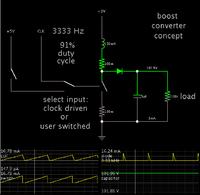Sherif8
Newbie level 5
Hello everybody!
I'm trying to design a boost power supply stepping up from 9v to 105v
**broken link removed**
The first stage is simply a level shifter. I tried to apply the equations in TI application note here **broken link removed** but it didn't work. The change of the pulse width doesn't matter at all with the value of the final output which settles on the VDSsat of the IRF no matter what the values of the coil and the capacitor are! This doesn't sound any logic at all!!
Any help please?
Note: I posted a thread before regarding this issue and i got a solution regarding the specs back then, the specs now changed and i thought a new thread would be more practical.
I'm trying to design a boost power supply stepping up from 9v to 105v
**broken link removed**
The first stage is simply a level shifter. I tried to apply the equations in TI application note here **broken link removed** but it didn't work. The change of the pulse width doesn't matter at all with the value of the final output which settles on the VDSsat of the IRF no matter what the values of the coil and the capacitor are! This doesn't sound any logic at all!!
Any help please?
Note: I posted a thread before regarding this issue and i got a solution regarding the specs back then, the specs now changed and i thought a new thread would be more practical.
